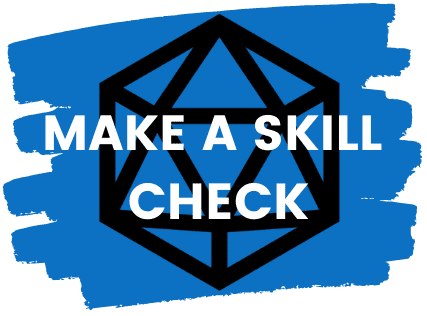Four to five hours—sometimes even less—is all it takes to have a complete D&D experience. Not a multi-level grand opera of world-changing heroics, just a neat, self-contained mini-arc. Hook, buildup, payoff. This is what is called a one-shot. Done right, it’s great fun, an ideal homebrew testing ground, and an opportunity for the usual DM in your group to be a player (to all you forever DMs reading: I appreciate you).
One-shots are different from regular D&D sessions. Time constraints force a more linear structure. Increased DM guidance is both necessary and expected. When running one, you need to roll with the punches players throw at you. Be careful not to over prep; one or two pages will do.
What do I mean that one or two pages will do? Well, let’s begin by first discussing…

Table of Contents
A Warning
The first time I ever ran D&D, I expected my murder mystery to be an 8-hour one-shot (that’s how my group used to roll). I ended up with a 40-hour-ish mini-campaign spanning three weekends of play.
How? I came to the table with a small town-worth of Non-Player Characters (NPCs) and their relationships and intrigues, many locations, a good bit of local history written down, more random encounters than I knew what to do with, and more. At least I didn’t have to do any more prep than I had at the start.
Now, how do we make sure your one-shot actually fits one play session without skimping on the good stuff? Play your cards right, and you can get all of this in a one-shot:
- a good story,
- all the three pillars of play (social, combat, exploration) in there,
- and even character development.
In this article, I’ll show you how.
5e One-Shot Structure and Prep
Putting the most valuable advice upfront: the four to five hours of the session usually only fit four to five encounters, unless your group is abnormally good at quick decision-making and somehow keeps table-chatter to a minimum. This number can go up if you’re DMing for a solo player (which is its own beast, explored here).
Naturally, if your group is game for enormous sessions (peak insanity for mine was the 12-hour New Year’s Eve evil one-shot), you can add more content.
Nonetheless, the point is: don’t go overboard if you want everything to fit the time you have.
Don’t attempt to out-prepare your player’s ability to surprise you. You can’t. Even when making an effort to play along for the sake of keeping things short, they will surprise you. Prevent wasted prep; give yourself wiggle-room.
With that in mind, we can talk about structure. For a self-contained story, you want to hook your players, build upon their engagement, then pay it off with a climactic resolution—just like in an episodic TV show.
Looking to challenge your players?
Puzzles and Riddles can be tricky! Too easy and they’re pointless; Too hard and it’s pure frustration. What is a DM to do?
Well, our friends over at Dungeon Vault have an assortment of puzzles, riddles, and tokens to enhance your gaming experience. They even have a murder mystery and a political intrigue system!
For easy-to-use resources for any D&D game, check out the selections at Dungeon Vault!
The Hook
The hook doesn’t even have to happen in-game:
You can tell the players what the story setup is well in advance and work with them to create characters that already know each other and have stakes in the adventure. Then you give them time to psyche themselves up about it and slowly ratchet up the tension once the game is on.
Alternatively, you can have disparate characters brought together by an inciting incident at the start of the one-shot. Treat them to a hot start!
Here’s a possible hot start: The Player Characters (PCs) were all enjoying a nice Midsummer festival when the elven terrorists started fireballing the crowd and raining arrows from the rooftops!
After surviving the initial onslaught and helping the towns guard disperse the attackers, the PCs band together to give chase:
- Griska, a dragonborn paladin of Bahamut, is compelled by her Oath of Vengeance to make sure the mass murder doesn’t go unpunished. Her justice is a platinum fist.
- Elven wizard, Zynfael, is appalled by the senseless violence and what it can do to the public perception of elves, remembering all too well the pogroms of the past. He wants a prominent elf to be seen bringing about justice: himself.
- The gruff human fighter, Orvar, expects to be paid handsomely for dragging the terrorist leader alive to the chopping block. They’ll spend it all on booze and gambling debts.
- The gnome artificer, Bryn, is furious about the destruction of his wonderful one-construct-band by the terrorist’s wanton fireballing. Years of work and hundreds of gold pieces wrecked in seconds. They’ll pay for it.
The Build-Up
Once you have everyone hooked, you build up. This can take the form of a dungeon crawl, an investigation, a hunt, or whatever else you can dream up. That’s when you make sure to diversify things and allow every character type to shine. Make sure to include encounters that can be solved with social skills or exploring the environment.

As I said in our article about making engaging campaigns:
“Ideally, the types of encounters in a session will not all be the same, or, if they are, they’ll be flavored by different circumstances and stakes, and have little speed bumps or set pieces in-between.”
The Payoff
Then you wrap it up. The climax of a one-shot is likely to be a fight due to D&D’s nature, but it doesn’t have to be!
What if your one-shot is about saving an innocent from execution by gathering evidence in their favor and enlisting allies in court? Or maybe, in the end, the PCs must run against the clock to prevent the local earl from drinking poisoned wine? Your imagination is the only limit.
On that note, you can save your tired DM brain from having to imagine too much on the fly. Keeping up with the PCs is a lot; no need to generate cool descriptions in real-time.
Have paragraphs of evocative description for locations, characters, important events, and key objects at hand for when you sit down to play.
Don’t Be Stingy With Information; Keep The Ball Rolling
This one is short but merits its own section nonetheless. Do you want to minimize time lost to doubt, confusion, and arguing among players? Then give them the information they need!
They failed the Investigation check or whatever? Throw an encounter at them to drain their resources, but give them the information before too much time passes. Find a way. Nobody likes spinning their wheels in frustration, especially when the clock is ticking.
If things get bogged down, improvise to push the session forward. Have them overhear key information, find a misplaced letter, or a convenient NPC appears from a formerly-hidden door.
On that note, if the PCs find a way to circumvent your clever encounter and the answers they’d be rewarded with for beating it, that’s a good time to meet an NPC who may help them… for a price. Having one of these in your pocket is one of the best ways to spend your prep time.
Spice It Up; Unleash The Homebrew!
Another neat thing about one-and-done adventures like this is that they’re low-stakes environments to test out homebrew material. You get willing playtesters; the players get a unique experience no one else has had because of the original content straight from your brain!
You can structure an entire one-shot around one weird new monster you made. Want to learn how to make monsters? Here’s the section dedicated to it.
Want to test how game-ready your homebrew class is? Ask one of the players in the one-shot to play it! I made the Cat Patron for warlock for my girlfriend when I enlisted her to playtest my horror adventure. Double the playtest: I learned a lot! Here’s my approach to making new classes.
It works for homebrew spells and magic items that you’re unsure about letting loose in your long-form campaigns, too. Shockingly, I’ve also written about that here.
Another way to spice up a one-shot is by introducing an element of randomness to it with dice roll tables or decks of cards (such as this deck of prophecies).
Encounters, loot, environmental conditions (if there’s a Tempest cleric in your party, you care about the weather), etc. You can also use the same content as a grab bag of tricks to deploy on a whim or as a reaction to player choices.
Encouraging Roleplay and Character Development in a One-Shot
You don’t need a sprawling epic to get character development to happen at the table. People sometimes think character development is about big picture things—redemption/corruption arcs, long-winded romance, taking a political stance—but it isn’t just that.
Conquering a fear, growing closer to another character, taking a risk to do the right thing, doing evil because it’s more convenient—these all count.
Naturally, you need the type of player that cares about this sort of thing to get it to happen. The responsibility isn’t entirely on them, however. Here’s what you can do to foster roleplay and character development:
- Encourage your players to link up their PC’s backstories, creating relationships and rapport. They don’t need to all have a rich history together, but if a couple does, it enhances everything.
- Encourage your players to create characters that bring personal issues to the table. Bonus points if the issues connect with the plot.
- Lead by Example—Portray complex NPCs.
- Have NPCs ask personal questions to your PCs or demand specific actions from them.
- Present tough choices. Help the child-eating hag for a mighty favor? Surrender the animal from an endangered species to the highest bidder?
Free example one-shot: The Giant Spotted Owlbear
In case you missed it, we have a free 5e one-shot that you can learn from! Click on this banner to get your copy:

It’s written by me, the man whose advice you’ve been reading. Since you got this far, I’d wager you don’t take me for a fool.
The reason why I’m talking about it is that all of what you’ve just read was on my mind when I wrote it. You can run it and take note of how all these principles translate into the actual design of a one-shot, or just strip it for parts!
The Silver Snake Rapids encounter is a banger if I don’t say so myself.
Summary
A short and to-the-point article to help you run short and to-the-point adventures! I hope it was illuminating. As usual, here are the key takeaways:

- Four to five encounters in four to five hours, a bit more if DMing for a solo player.
- One-shots are more linear, and that’s fine.
- Formula: Hook, buildup, payoff.
- Avoid over preparing: most of the time, one to two pages of preparation will do.
- Include social gameplay and environmental exploration as well as combat.
- Be generous with information to keep the ball rolling.
- Spice it up with homebrew: monsters, classes, items, spells, etc. How? Read more here.
- Foster roleplay to take it to the next level (More reading here). Encourage players to make characters with prior relationships and issues.







0 Comments